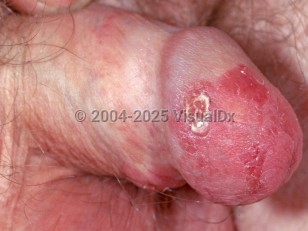Erythroplasia of Queyrat - Anogenital in
Alerts and Notices
Important News & Links
Synopsis

Erythroplasia of Queyrat (EPQ) is a squamous cell carcinoma in situ (SCCIS) of the glans penis. The disorder is rare and comprises less than 1% of malignancies that affect males. It should be considered a type of Bowen disease, which is SCCIS at any location. The lesion is a precursor for invasive squamous cell carcinoma (SCC) and is unlikely to remit spontaneously.
EPQ classically presents as a well-demarcated, velvety, erythematous plaque, but its appearance may be variable.
The entity is considered a high-grade squamous intraepithelial lesion / neoplasia (HSIL) histologically. It is a subtype of HPV-associated penile intraepithelial neoplasia (HPV-associated PeIN; this term also includes bowenoid papulosis). It is most commonly due to human papillomavirus (HPV) type 16. HPV types 18, 26, 31, 33, and 53 have also been implicated. It is more common in elderly, uncircumcised males. EPQ and penile cancer in general has a much higher incidence in non-Western countries likely due to cultural circumcision habits, as circumcision reduces risk.
Risk factors believed to contribute to the development of EPQ include lack of circumcision, Zoon balanitis, HPV infection, immunosuppression (such as human immunodeficiency virus [HIV] infection), ultraviolet (UV) light exposure, phimosis, multiple sexual partners, smoking, other underlying dermatoses (lichen sclerosus, erosive / hypertrophic lichen planus), and any form of chronic irritation, inflammation, or infection. Examples of chronic insults include trauma, herpes simplex virus infection, heat, friction, trauma, urine, and smegma.
If left untreated, EPQ will eventually develop into invasive SCC in one-third of cases.
EPQ classically presents as a well-demarcated, velvety, erythematous plaque, but its appearance may be variable.
The entity is considered a high-grade squamous intraepithelial lesion / neoplasia (HSIL) histologically. It is a subtype of HPV-associated penile intraepithelial neoplasia (HPV-associated PeIN; this term also includes bowenoid papulosis). It is most commonly due to human papillomavirus (HPV) type 16. HPV types 18, 26, 31, 33, and 53 have also been implicated. It is more common in elderly, uncircumcised males. EPQ and penile cancer in general has a much higher incidence in non-Western countries likely due to cultural circumcision habits, as circumcision reduces risk.
Risk factors believed to contribute to the development of EPQ include lack of circumcision, Zoon balanitis, HPV infection, immunosuppression (such as human immunodeficiency virus [HIV] infection), ultraviolet (UV) light exposure, phimosis, multiple sexual partners, smoking, other underlying dermatoses (lichen sclerosus, erosive / hypertrophic lichen planus), and any form of chronic irritation, inflammation, or infection. Examples of chronic insults include trauma, herpes simplex virus infection, heat, friction, trauma, urine, and smegma.
If left untreated, EPQ will eventually develop into invasive SCC in one-third of cases.
Codes
ICD10CM:
D07.4 – Carcinoma in situ of penis
SNOMEDCT:
398768004 – Erythroplasia of Queyrat
D07.4 – Carcinoma in situ of penis
SNOMEDCT:
398768004 – Erythroplasia of Queyrat
Look For
Subscription Required
Diagnostic Pearls
Subscription Required
Differential Diagnosis & Pitfalls

To perform a comparison, select diagnoses from the classic differential
Subscription Required
Best Tests
Subscription Required
Management Pearls
Subscription Required
Therapy
Subscription Required
References
Subscription Required
Last Reviewed:09/19/2018
Last Updated:08/24/2025
Last Updated:08/24/2025
Erythroplasia of Queyrat - Anogenital in

